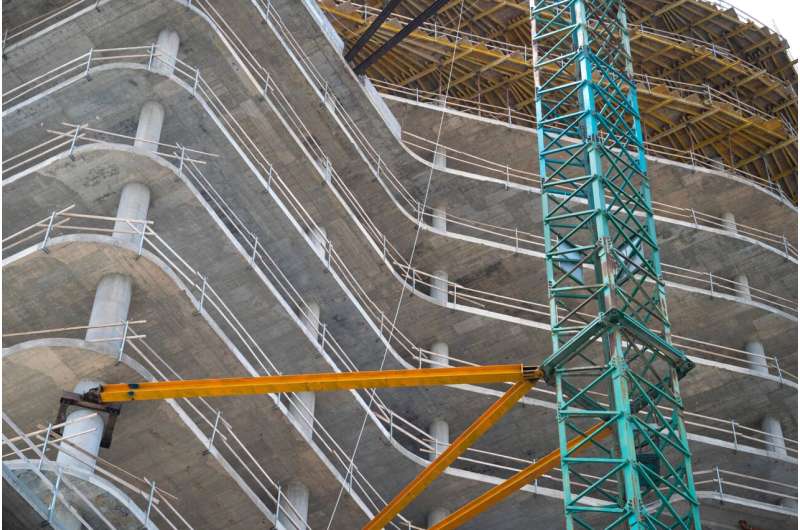This article has been reviewed according to Science X's editorial process and policies. Editors have highlighted the following attributes while ensuring the content's credibility:
fact-checked
peer-reviewed publication
trusted source
proofread
Boosting concrete's ability to serve as a natural 'carbon sink'

Damian Stefaniuk is a postdoc at the MIT Concrete Sustainability Hub (CSHub). He works with MIT professors Franz-Josef Ulm and Admir Masic of the MIT Department of Civil and Environmental Engineering (CEE) to investigate multifunctional concrete. Here, he provides an overview of carbonation in cement-based products, a brief explanation of why understanding carbonation in the life cycle of cement products is key for assessing their environmental impact, and an update on current research to bolster the process.
Q: What is carbonation and why is it important for thinking about concrete from a life-cycle perspective?
A: Carbonation is the reaction between carbon dioxide (CO2) and certain compounds in cement-based products, occurring during their use phase and end of life. It forms calcium carbonate (CaCO3) and has important implications for neutralizing the GHG [greenhouse gas] emissions and achieving carbon neutrality in the life cycle of concrete.
First, carbonation causes cement-based products to act as natural carbon sinks, sequestering CO2 from the air and storing it permanently. This helps mitigate the carbon emissions associated with the production of cement, reducing their overall carbon footprint.
Second, carbonation affects concrete properties. Early stage carbonation may increase the compressive strength of cement-based products, enhancing their durability and structural performance. However, late-stage carbonation can impact corrosion resistance in steel-reinforced concrete due to reduced alkalinity.
Considering carbonation in the life cycle of cement-based products is crucial for accurately assessing their environmental impact. Understanding and leveraging carbonation can help industry reduce carbon emissions and maximize carbon sequestration potential. Paying close attention to it in the design process aids in creating durable and corrosion-resistant structures, contributing to longevity and overall sustainability.
Q: What are some ongoing global efforts to force carbonation?
A: Some ongoing efforts to force carbonation in concrete involve artificially increasing the amount of CO2 gas present during the early stage hydration of concrete. This process, known as forced carbonation, aims to accelerate the carbonation reaction and its associated benefits.
Forced carbonation is typically applied to precast concrete elements that are produced in artificially CO2-rich environments. By exposing fresh concrete to higher concentrations of CO2 during curing, the carbonation process can be expedited, resulting in potential improvements in strength, reduced water absorption, improved resistance to chloride permeability, and improved performance during freeze-thaw. At the same time, it can be difficult to quantify how much CO2 is absorbed and released because of the process.
These efforts to induce early stage carbonation through forced carbonation represent the industry's focus on optimizing concrete performance and environmental impacts. By exploring methods to enhance the carbonation process, researchers and practitioners seek to more efficiently harness its benefits, such as increasing strength and sequestering CO2.
It is important to note that forced carbonation requires careful implementation and monitoring to ensure desired outcomes. The specific procedures and conditions vary based on the application and intended goals, highlighting the need for expertise and controlled environments.
Overall, ongoing efforts in forced carbonation contribute to the continuous development of concrete technology, aiming to improve its properties and reduce its carbon footprint throughout the life cycle of the material.
Q: What is chemically induced pre-cure carbonation, and what implications does it have?
A: Chemically induced pre-cure carbonation (CIPCC) is a method developed by the MIT CSHub to mineralize and permanently store CO2 in cement. Unlike traditional forced carbonation methods, CIPCC introduces CO2 into the concrete mix as a solid powder, specifically sodium bicarbonate. This approach addresses some of the limitations of current carbon capture and utilization technologies.
The implications of CIPCC are significant. First, it offers convenience for cast-in-place applications, making it easier to incorporate CO2 use in concrete projects. Unlike some other approaches, CIPCC allows for precise control over the quantity of CO2 sequestered in the concrete. This ensures accurate carbonation and facilitates better management of the storage process. CIPCC also builds on previous research regarding amorphous hydration phases, providing an additional mechanism for CO2 sequestration in cement-based products. These phases carbonate through CIPCC, contributing to the overall carbon sequestration capacity of the material.
Furthermore, early stage pre-cure carbonation shows promise as a pathway for concrete to permanently sequester a controlled and precise quantity of CO2. Our recent paper in PNAS Nexus suggests that it could theoretically offset at least 40% of the calcination emissions associated with cement production, when anticipating advances in the lower-emissions production of sodium bicarbonate.
We also found that up to 15% of cement (by weight) could be substituted with sodium bicarbonate without compromising the mechanical performance of a given mix. Further research is needed to evaluate long-term effects of this process to explore the potential life-cycle savings and impacts of carbonation.
CIPCC offers not only environmental benefits by reducing carbon emissions, but also practical advantages. The early stage strength increase observed in real-world applications could expedite construction timelines by allowing concrete to reach its full strength faster.
Overall, CIPCC demonstrates the potential for more efficient and controlled CO2 sequestration in concrete. It represents an important development in concrete sustainability, emphasizing the need for further research and considering the material's life-cycle impacts.
This story is republished courtesy of MIT News (web.mit.edu/newsoffice/), a popular site that covers news about MIT research, innovation and teaching.

















